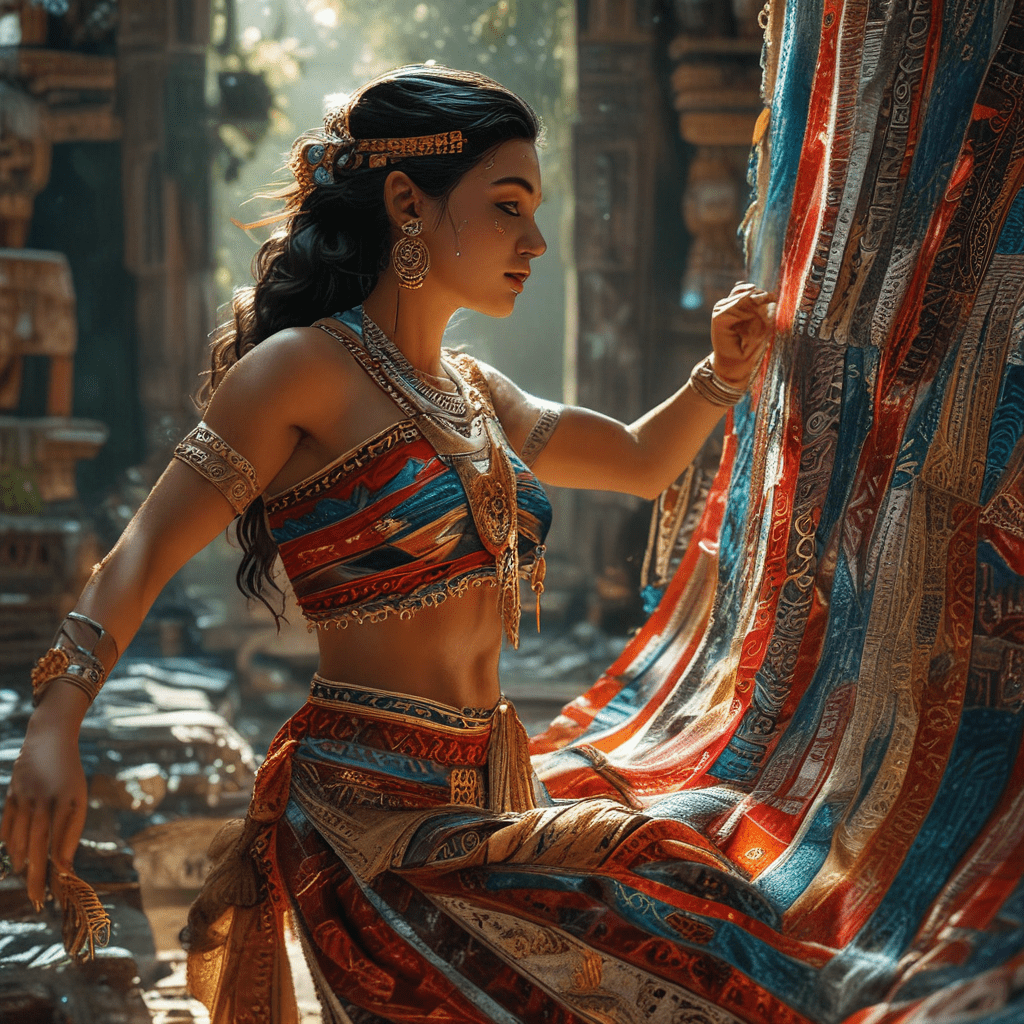Understanding Mayan Mythological Textiles: Weaving Stories of the Gods
The ancient Maya civilization, known for its sophisticated writing system, intricate calendar, and impressive architecture, also possessed a rich and vibrant textile tradition. Intertwined with the Maya’s complex mythology, their textiles were not merely decorative objects but served as powerful tools for storytelling, ritual practice, and social expression. This article delves into the fascinating world of Mayan mythological textiles, uncovering the divine threads that connect the material world with the realm of the gods.
Divine Threads: The Significance of Textiles in Mayan Mythology
Textiles played a central role in Maya mythology, serving as tangible representations of the gods, their narratives, and the cosmos. For the Maya, textiles were imbued with religious meaning and considered sacred objects worthy of veneration. They believed the gods themselves wove the first textiles and taught this art to humans. Weaving became a sacred act, with women playing a crucial role as intermediaries between the divine realm and the human world.
Textiles were also intricately linked to the concept of the World Tree, a central motif in Maya mythology representing the connection between the underworld, the earth, and the heavens. The vertical threads on a loom symbolized the World Tree, connecting the celestial realm above with the earthly realm below. The act of weaving mirrored the creation of the cosmos, with each new textile reflecting the ongoing cycle of life, death, and regeneration.
Weaving the Cosmos: Textiles as Representations of the Mayan Universe
Mayan textiles served as woven maps of the Maya cosmos, depicting deities, celestial bodies, and the various levels of existence. The intricate designs and motifs encoded complex astronomical observations, religious narratives, and historical events. Textiles reflected the Maya’s deep understanding of the natural world and their intricate cosmology, weaving stories of gods, heroes, and the origins of the universe into their fabric.
The gods and goddesses were often portrayed on textiles, adorned with their respective symbols and associated attributes. Representations of the sun god, the rain god, and the maize god adorned textiles, highlighting their importance in Maya mythology and agricultural practices. These deities were believed to reside in the celestial realm above, accessible through the World Tree, and textiles served as a means of communication and appeasement.
Mythic Narratives: Depicting Gods, Heroes, and Rituals on Cloth
Mythological narratives and scenes from Maya epics, such as the Popol Vuh, were woven onto textiles, offering a visual tapestry of their cultural heritage. The exploits of the Hero Twins, Hunahpu and Xbalanque, their battles with the underworld gods, and their journey through the celestial realm were immortalized on textiles. These stories served as moral lessons, reinforcing social values and reminding individuals of their place within the cosmic order.
Textiles also played a vital role in Maya rituals and ceremonies. They were used as offerings to appease the gods, adorn sacred spaces, and mark significant life passages such as birth, marriage, and death. The designs and colors of the textiles held specific symbolic meanings, conveying prayers, wishes, and invocations to the divine realm. Ritual textiles served as a bridge between the physical world and the spiritual realm, facilitating communication and ensuring a harmonious relationship with the gods.
The Creation Myth: Textiles as a Reflection of the Origin Story
The Maya creation myth, recounted in the Popol Vuh, is vividly depicted on textiles, weaving a visual narrative of the emergence of the cosmos and humanity. The textiles showcase the creation of the first humans from maize, their trials and tribulations in the underworld, and their eventual ascent to the heavens.
These woven representations of the creation myth served as reminders of the Maya people's origins and their connection to the divine. They reinforced the importance of maize as a sacred crop and emphasized the cyclical nature of life, death, and renewal.
Heroic Deeds: Depictions of the Maya Hero Twins on Cloth
The exploits of the Maya Hero Twins, Hunahpu and Xbalanque, are prominently featured on textiles, showcasing their courage,智慧, and divine intervention. The twins' battles with the underworld gods, their retrieval of the ball used in the sacred Maya ball game, and their transformation into the sun and moon are vividly portrayed on woven tapestries.
These depictions served as a celebration of bravery, resilience, and the triumph of good over evil. They served as moral exemplars for Maya individuals, encouraging them to face challenges with determination and to strive for greatness.
Ritual Significance: The Role of Textiles in Mayan Religious Ceremonies
Textiles played a crucial role in Maya religious ceremonies, serving as offerings to the gods, adornments for sacred spaces, and symbolic representations of prayers and invocations. Elaborate textiles were woven specifically for ritual purposes, featuring motifs and colors associated with specific deities and rituals.
These textiles served as intermediaries between the human and divine realms, conveying messages, pleas, and offerings to the gods. They facilitated communication, appeasement, and the maintenance of a harmonious relationship between the Maya people and their deities.
Textile Production: Techniques, Materials, and Artistic Expression
Mayan textiles were renowned for their intricate designs, vibrant colors, and sophisticated weaving techniques. Maya artisans employed various weaving techniques, including backstrap looms and tablet weaving, to create complex patterns and motifs. They utilized natural dyes derived from plants, insects, and minerals to produce a rich palette of colors that enhanced the symbolism and visual impact of their textiles.
Maya textile production was a highly specialized craft, with skilled artisans passing down their knowledge and techniques through generations. Their artistry reflected their deep understanding of the natural world, their religious beliefs, and their cultural identity.
Interpreting the Past: Textiles as a Window into Mayan Culture and Beliefs
Mayan textiles offer invaluable insights into the cultural beliefs, social practices, and religious rituals of the ancient Maya civilization. They provide a unique window into the Maya worldview, revealing their understanding of the cosmos, their relationship with the gods, and their artistic expression.
By studying Maya textiles, we can gain a deeper understanding of their complex mythology, their sophisticated weaving techniques, and their profound connection to their cultural heritage. The study of Maya textiles continues to provide valuable insights into the rich and multifaceted world of this ancient civilization.
Preserving the Legacy: The Importance of Studying and Protecting Mayan Textile Art
The study and preservation of Maya textile art is crucial for ensuring the延续 of this invaluable cultural heritage. By studying and documenting extant textiles, we can gain a deeper understanding of Maya culture and history. Conservation efforts are essential to protect these fragile artifacts from deterioration and ensure their accessibility for future generations.
Through museums, research institutions, and cultural organizations, we can preserve the legacy of Maya textile art, ensuring that its beauty, symbolism, and cultural significance continue to inspire and enlighten future generations.
FAQ
What are some of the most common motifs found on Mayan mythological textiles?
Common motifs include representations of gods, goddesses, celestial bodies, animals, plants, and symbols associated with the Maya cosmology and creation myth.
What materials were used to make Mayan textiles?
Maya textiles were primarily made from cotton, with some examples also utilizing agave fibers and feathers.
Where can I see examples of Mayan mythological textiles?
Examples of Mayan mythological textiles can be found in museums and cultural institutions worldwide, including the National Museum of Anthropology in Mexico City, the Metropolitan Museum of Art in New York City, and the British Museum in London.
What are some of the challenges facing the preservation of Mayan textiles?
Challenges include environmental factors, such as humidity and temperature, as well as damage from handling and exposure to light.



